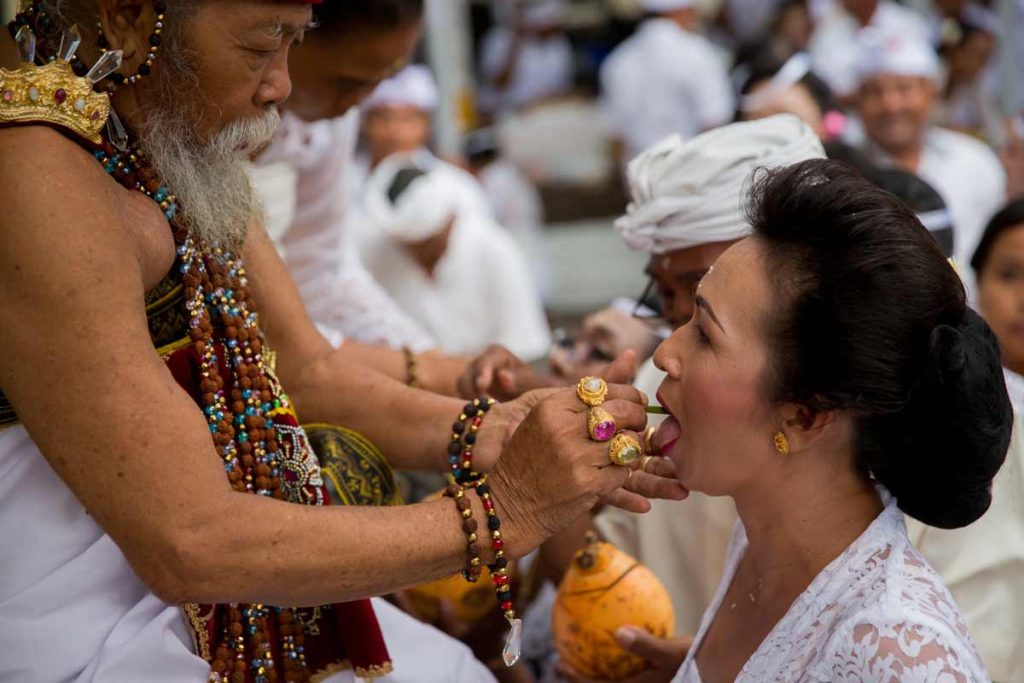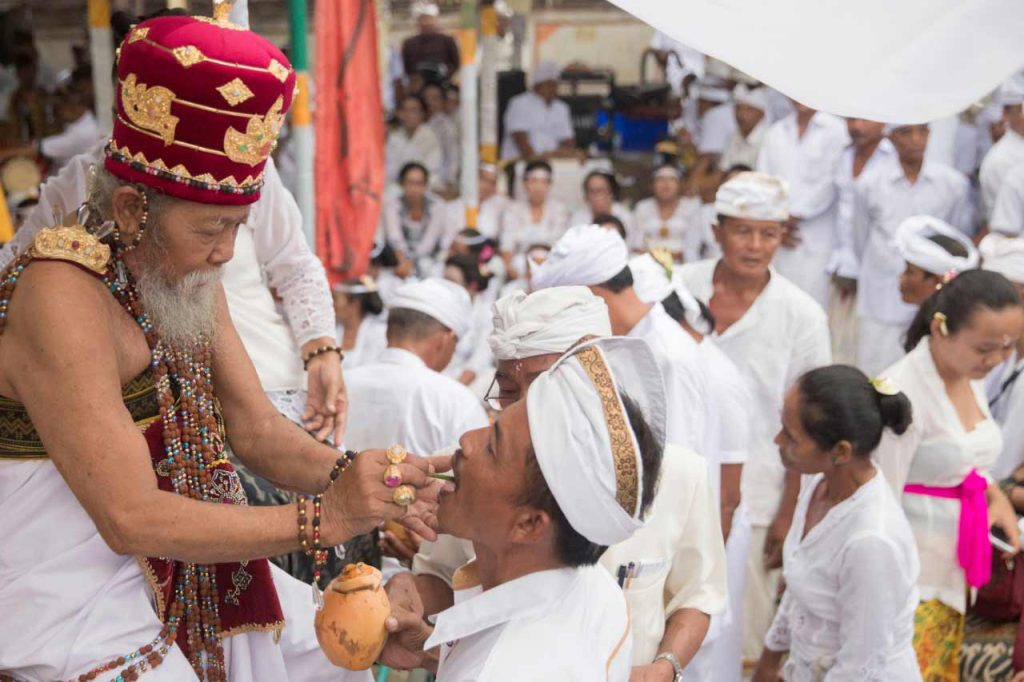The shrill and accelerating jingle of the bell accompanies and almost drowns out the soft muttering of a man’s voice, lotus-sitting, in the small thatched pavilion, high above and alone, his head capped by an extraordinary tiara. This is a high priest performing meweda, a call addressed to the gods of the cardinal points, the gods of the mountains, all the gods and God indeed, so that they all come down and dwell in the souls and minds of the seven men lotus-seated in front of him. They are waiting for the symbolic writing of the sacred letters on the tip of their tongue, one of the phases of the Pawintenan ceremony.
The pawintenan ceremony is a traditional blessing, performed by a pedanda high-priest, which inducts a person to higher level of being. It is meant to cleanse the soul of all traces of the sadripu, the six inner enemies of any human: anger, sexual desire, jealousy, insolence, envy and greed. Having been cleansed, the person may perform holy duties.

Pawinten Ceremony, Photo by IB Putra Adnyana
Bali being what it is, complicated, there are several types of pawintenan: pawintenan di bunga, or flower cleansing; pawintenan Saraswati, after the name of goddess of knowledge; pawintenan tirta, holy water cleasing; pawintenan Kusuma, holy flower Kusuman cleansing; and pawintenan Kesuma Gandawati, the Gandawati holy flower cleansing. Each has a different ritual function and brings about a different level of purity.
The pawintenan bunga is the most elementary: it comes upon the completion of the first calendar cycle of the newly born human, when the baby has his/her first Balinese otonan “birthday”/anniversary, that comes 210 days after the birth. It definitively “installs” the soul as that of an incarnated person. The pawintenan bunga should be repeated at least three times during one’s life, as a way to recover purity.
The pawintenan Saraswati is a ceremonial blessing that aims at enabling a person to practice the arts under the protection of the goddess Saraswati, the goddess of knowledge, whose days closes the 210 days calendar and separates the week consecrated to the incestuous son to the week consecrated to the incestuous mother.
The pawintenan tirta is the purification blessing of a group. For example, a group of people who are accepted as new members of a temple congregation.
The pawintenan Kusuma is an ordainment. It is said to constitute a wedding with the gods, and is reserved for temple priests, balian healers/shamans, trance dancers and the like.
The pawintenan Kusuma Gandawati is almost the same as the former, but it is addressed to the ordainment of the priest in charge of the temple of the dead (pura dalem), the one that deals with Batari Durga, the goddess of the dead.
Back to the seven men lotus-seated in front of the high priest, who will perform a Pawintenan Tirta to bless the forming of their kidung reading group, they have all addressed, in their respective family temples, a “notification” pejati offering to Batara Guru, the Lord of the Ancestors, and now they are in the high-priest mansion, waiting for the latter to bestow them with his blessings. All dressed in white with a yellow sash, they sit silently while the priest reads his mantra holy formulas, perform his mudra holy gestures, jingles his holy bell and then drops a flower in the vessel just in front of him. They are all waiting.

Pawinten Ceremony, Photo by IB Putra Adnyana
When the priest has completed his holy muttering, it means that the holy water is ready, turned into Tirta , the holy water of the gods. This is now the time of prayer, which they perform together. First, they raise their folded hands, empty, to address a prayer to Embang or Acintya, the Supreme Lord of the Void. Then, picking up a white flower at the tip of their folded hands, they address a prayers first to Surya, the sun god, then to Durga, the ruler of the dead, then to the gods of the mountains and the sea, until they address again their last prayer, their hands empty, to the Lord of the void.
The high-priest, in the meantime, has prepared holy honey and a stick of betel. Honey is said to be the symbol of duration, whereas the stick of betel is said to symbolise the goddess of knowledge, Saraswati, and will be used as a pen. The priest then approaches the row of the waiting men and proceeds to writing holy syllables (rajah). What are those holy syllables? They are the ang and the ah, which symbolise the complementary opposites of the world. He writes them on the forehead, then on the eyelids, and then, face to face, the one the reverse of the other, on the tongue, as the symbol of the father and mother. Finally he writes on the chest of each the three holy syllables of Ang, Ung and Mang, symbol of the Trinity (Trimurti) of Brahma the creator, Wisnu the preserver and Siwa the destroyer.
This ritual of holy syllables reminds the participants that they are governed as individuals by the same principles with those that govern the entire universe. In Balinese, the ritual underlines and strengthens the links that exist between the “little world” (bhwana alit) of the person and the “large world” (Bhwana Agung) of the universe. The microcosm and macrocosm, respectively.
The process does not end with the writing of the holy syllables. When this writing is finished, on the head of all the participants is set a crown of alang alang, the grass that does not die, since it received the elixir of immortality at the origin of time. When this is over, they are given a “protective object” that they will throw at the mouth of a fire, as a reminder to the god brahman that they may not eat fish or meat for the next 42 days.
It must be said that the pawintenan may change from place to place.









